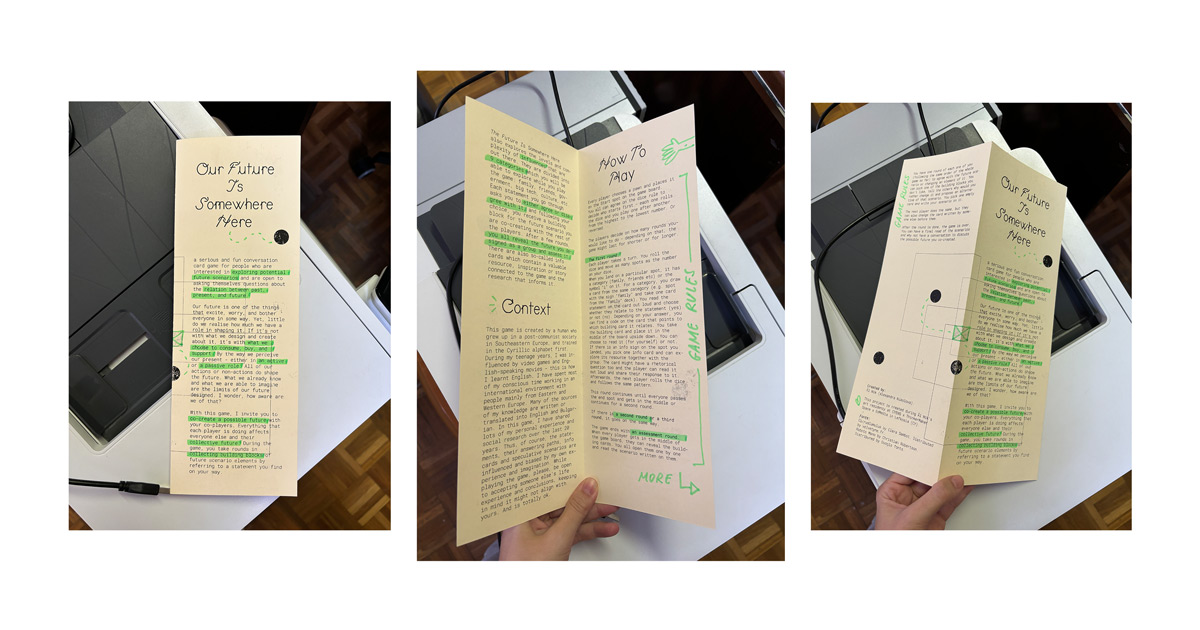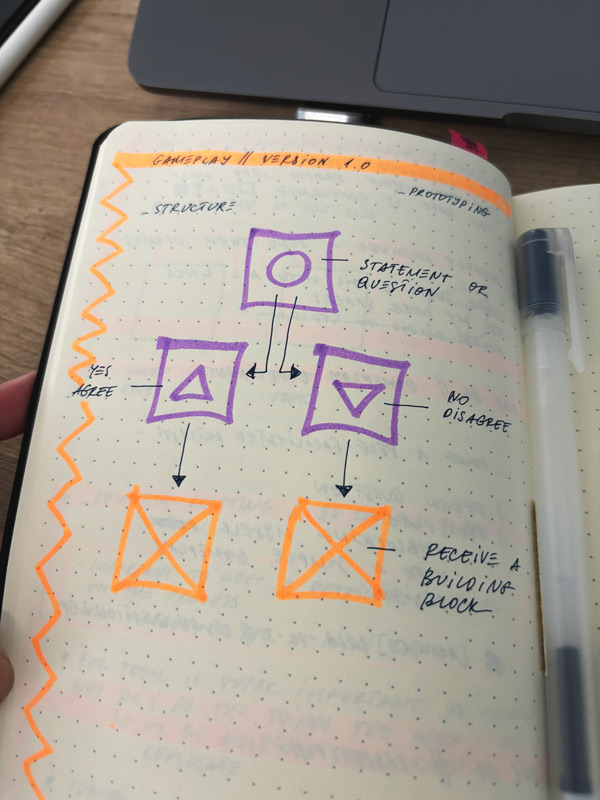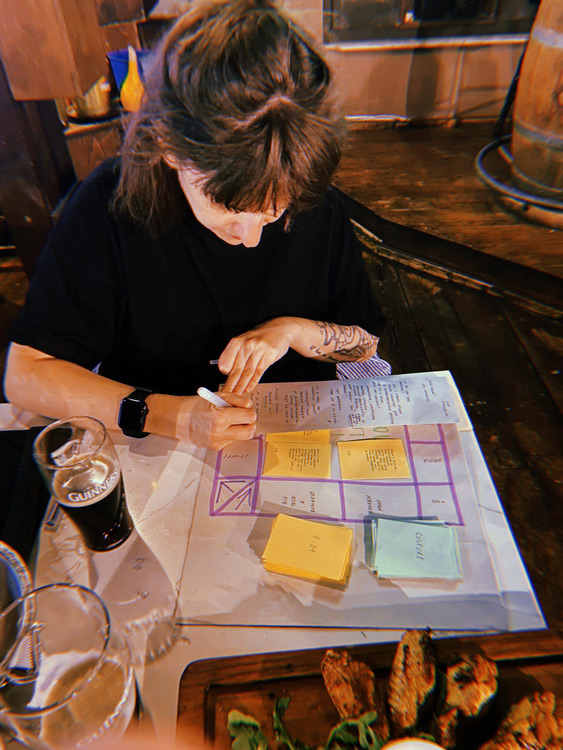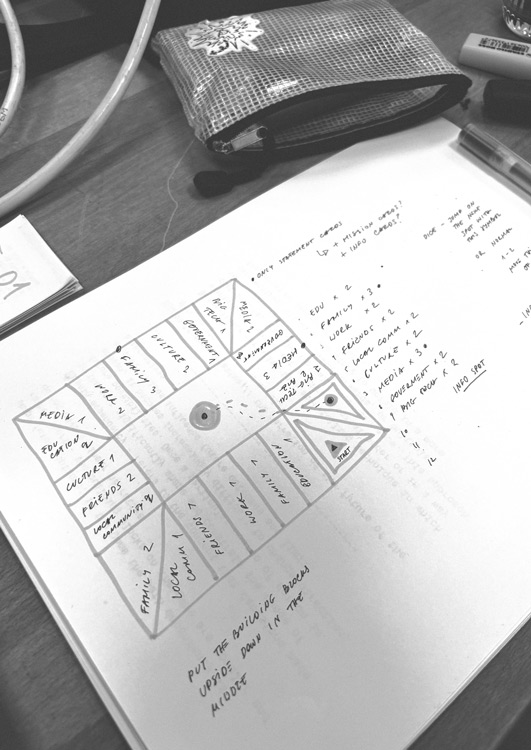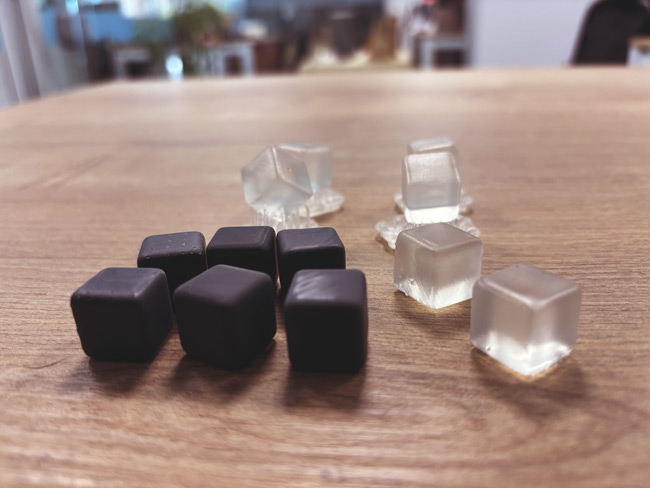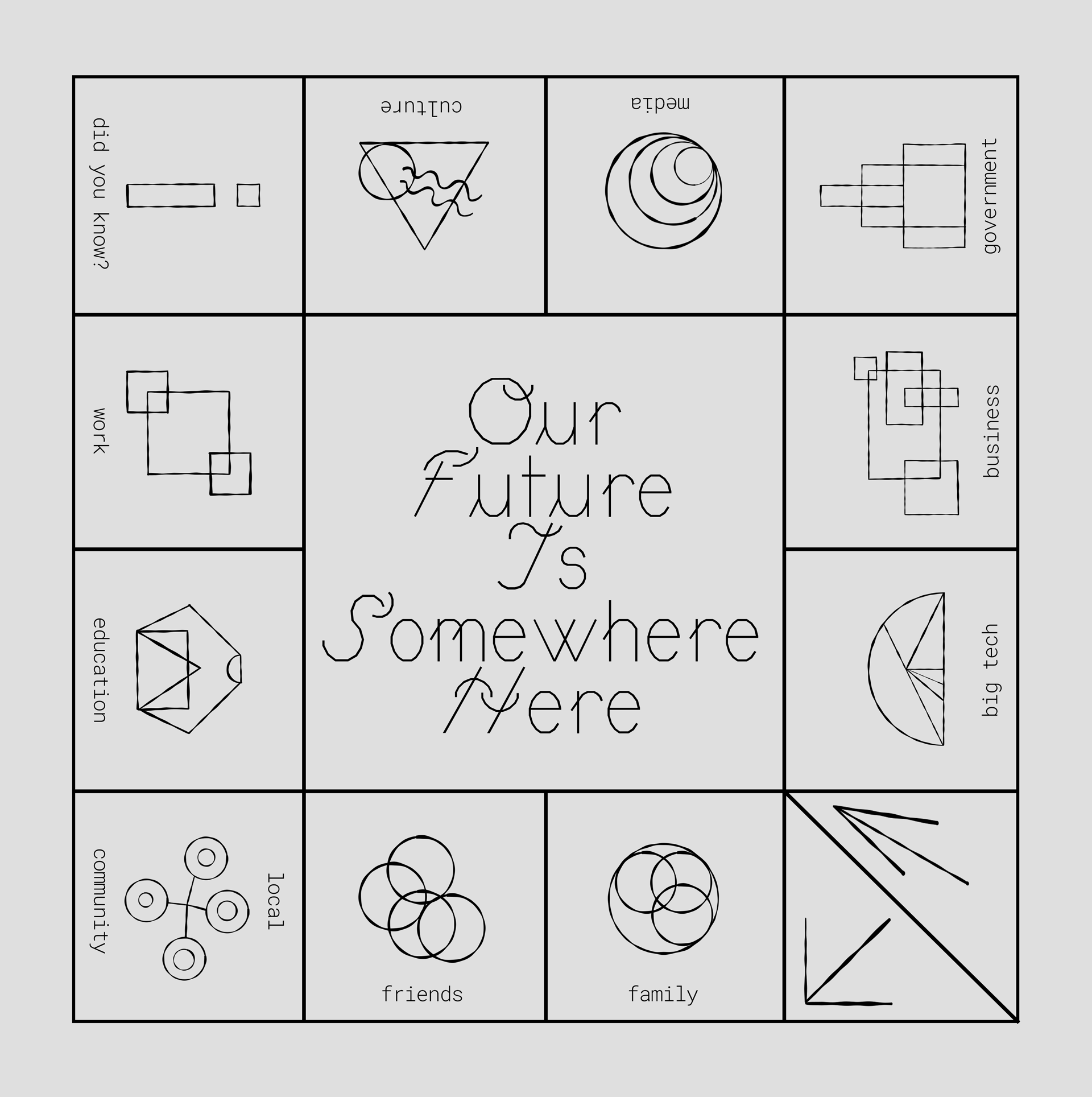Our Future Is Somewhere Here
_work-in-progress
// created during my CYENS Art Residency 2024
_editorial
// version 2.0 // 28-10-2024
// version 1.0 // 16-10-2024
_Introduction
Our Future Is Somewhere Here is a serious and fun conversation card game for people who are interested in exploring potential future scenarios and are open to asking themselves questions about the relation between past, present, and future.
Our future is one of the things that excite, worry, and bother everyone in some way. Yet, little do we realise how much we have a role in shaping it. If it’s not with what we design and create about it, it’s with what we choose to consume, buy, and support. By the way we perceive our present - either in an active or a passive role. All of our actions or non-actions do shape the future. What we already know and what we are able to imagine are the limits of our future designed. I wonder, how aware are we of that?
With this game, I invite you to co-create a possible future with your co-players. Everything that each player is doing affects everyone else and their collective future. During the game, you take rounds in collecting building blocks of future scenario elements by referring to a statement you find on your way.
Our Future Is Somewhere Here also explores the levels and complexity of influences that are out there. They are divided into 9 categories which you will be able to explore while you play the game: family, friends, government, big tech, culture, etc. Each statement you go through asks you to either agree or disagree with it, and following your choice, you receive a building block for the future scenario you are co-creating with the rest of the players. After a few rounds, you all reveal the future you designed as a group and assess it. There are also so-called info cards which contain a valuable resource, inspiration or story connected to the game and the research that informs it.
Will you leave with more questions than answers after playing the game?
_Goals of the game
With this game, I aim to bring awareness about how our past and present influence the future and especially our role in it. As human beings part of an extremely complex system, we often feel powerless and underestimate our role as individuals and as a community in shaping the future. In reality, our actions and non-actions actually matter - we are always part of a social system and as such, we influence the other parts of the same system.
I am also excited to create a space for connection. I would like to invite the players to be open to new discoveries during this game - about themselves and the others. This game is a facilitated conversation opener, be mindful of the others and give space for everyone to express and contribute. It is a collective game, not a game about competition.
This game also aims to bring an understanding of how designing a potential future could look like, what elements influence it, and what is our role in it.
_Context This game is created by a human who grew up in a post-communist society in Southeastern Europe, and trained in the Cyrillic alphabet first. During my teenage years, I was influenced by video games and English-speaking movies - this is how I learnt English. I have spent most of my conscious time working in an international environment with people mainly from Eastern and Western Europe. Many of the sources of my knowledge are written or translated into English and Bulgarian. In this game, I have shared lots of my personal experience and social research over the last 20 years. Thus, of course, the statements, their answering paths, info cards and speculative scenarios are influenced and biased by my own experience and imagination. While playing the game, please, be open to accepting someone else’s life experience and conclusions, keeping in mind it might not align with yours. And is totally ok.
_Methods
for designing the relation between statements and outcomes for the building blocks:
+ speculative fiction
+ exploration of possible worlds
+ path dependency
+ modularity and non-linear narration
+ counterfactual reasoning
+ simplification (sometimes extreme)
+ exaggeration (for dramatic effects)
+ entanglement (Karen Barad’s concept of agential realism: “all entities are intertwined, continually shaping and reshaping each other in the process of their existence”)
+ diffraction (Karen Barad, examining differences that emphasise interaction, transformation, and entangled relations rather than simple reflection or mirroring)
↳ examine how elements transform each other;
↳ to trace how differences are not fixed but relational.
_game design
_prototyping
The first sod of this project was laid back in 2022 during my first academic year at XPUB (my Master's programme in Experimental Publishing at the Piet Zwart Institute in Rotterdam). It was during the third special issue when we had artist and scholar Femke Snelting as a guest tutor. She introduced us the philosophical concept of "diffraction" originally developed by Karen Barad in her "Meeting the universe halfway" book from 2007. As an assignment, we had to do a "diffractive reading" of two different sources and create something out of it. As a result of my small experiment, I created this ▶▶Intersection between what we know as individuals and what we know as a collective data as a spot from where we can imagine and design a possible future. I revisited this idea again for my CYENS residency, because I was interested in seeing how far this idea can go. I opened the Pandora box.
While there was a whole universe of possible scenarios to research, I had to narrow it down. I wrote a note to myself, so I don’t get carried away and pinned it: “Keep it simple!”. So, while researching the topic of “future design”, I also had to create a game that was easy and fun to play. Going from a big idea into a small game was an extremely challenging route.
_Game structure
I started creating a simple card game. The idea was to come up with a mechanism for the players to create a possible future scenario as a group. In order to do that, I went for making a modular, non-linear narrative based on different levels of influence. I extracted 9 categories of elements that influence the way we form ourselves over the years: family, friends, local community, education, work, culture, media, government, and big tech & business. For each category, I created two statement cards and based on what the player will choose as an answer (would they relate to the statement or not), they collect one building block (card) for the future world. This way, one by one, the players will make a modular combination of future situation that together build a world they will live in.
Then, I added some additional elements to make a more playful gameplay and give the players a more visual environment. Thus, I made a game board for them to navigate through. And some pawns, dye, and additional cards - the info cards.
_Game testing
The game prototype was tested at several sessions. You can read more about the tests here.
_final version
_game elements
_game rules
_How To Play
Every player chooses a pawn and places it on the Start spot on the game board. From the start arrow on, the board has 10 categories spots and 1 info spot. Over the first round of the board, each player can choose two categories and one info card while taking turns. Once they finish one round, they can either enter the assessment round, or take another round with exploring more categories and statement cards.
▲ The first round: Each player takes a turn. As this is a collective game, there is no competition, therefore - it does not matter who starts first and who is last. They just take turn and for round 1, each player has 3 turns.
Each player picks one category to explore at each turn. They place their pawn on that spot and they cannot go back to a category spot they passed. Once they pick a spot for their pawn, the player draws a card from the same category (e.g. spot with the sign “family” - takes one card from the “family” deck). They read the statement on the card out loud and choose whether they relate to the statement (yes) or not (no) while also elaborating on their choice, so the rest of the players can understand it. Depending on their answer, they can find a code on the card that points to which building card it relates. They take the building card, read it out loud, and place it in the middle of the board. When they decide to land on the info sign spot, they pick one "did you know" card and explore it together with the group by also having a short discussion about its content. The card can have a rhetorical question and the player can read it out loud and share their response to it.
This round continues until everyone passes the end spot and gets in the middle or continues for a second round.
▲ If there is a second round or a third round, it goes on the same way.
▲ The game ends with an assessment round. When every player gets in the middle of the game board, they have a moment to assess the future they have built together. They read all of the building blocks and all the scenarios that are now part of their collective future. Now is the time to change it as much as they wish:
Every player is allowed to change one building block. They can either rewrite the whole card (by using the empty ones), or change only parts of it; or exchange it with another building block that was not picked during the game. The players can decide how to manage this collective moment - either to vote for which cards to change, or do it individually - it's up to them how their future design would look like.
After the round is done, the game is finished. The players can have a final read and they can have a conversation to discuss the possible future they co-created.
_In a nutshell:
1// Each player moves their pawn around the board and picks a category to explore via the statement and the building blocks. They start from the arrow and continue in the same direction without going back. 2// When a player lands on a category (like family or education), they pick one card from that category and read it out loud. Then, the answer with Yes or No to its statement and receive the building card referring to the code under their answer. When they get the building card, they place it in the middle of the board and the next player takes their turn. 3// When a player picks the “i” (info card) spot, they can draw a “did you know card” and read out loud its content. They can elaborate on it and have a discussion with the group before moving to the next player. 4// Each player can pick two categories and one info card per round. 5// Once the rounds are over, the players enter the middle of the board and the assessment round. They reveal the future they co-created and assess it. Every player is allowed to change one card (they can edit it or rewrite it using the blank cards).
_colophon
This project is created during Ål Nik’s art residency at CYENS x ThinkerMaker Space x EdMedia in Lefkosia (CY).
People:
I am grateful to Eleni Pashia, Sonia Andreou, Alex Charalambous, Stratis Pantelides, and Stella Taousiani for their support or mentorship during the residency.
Also to the people who tested the game with me and gave me valuable feedback: Oleg Kabakchiev, Eleni Pashia, Sonia Andreou, Alexia Achilleos, and Antonia Christou.
Fonts:
CirrusCumulus by Clara Sambot. Distributed by velvetyne.fr.
Roboto Mono Light by Christian Robertson. Distribured by Google fonts.
Reader & references:
▶ Future Design Reader
